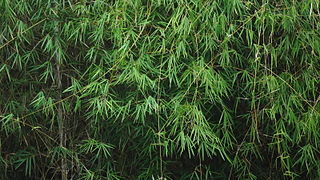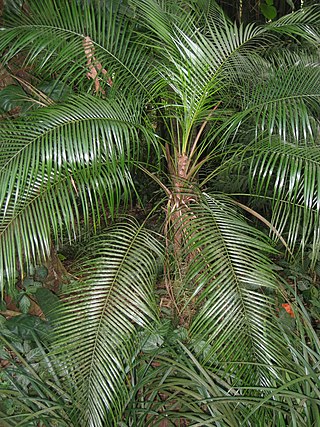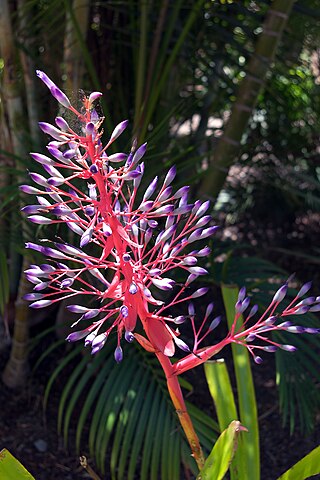
The Rutaceae is a family, commonly known as the rue or citrus family, of flowering plants, usually placed in the order Sapindales.

Chusquea is a genus of evergreen bamboos in the grass family. Most of them are native to mountain habitats in Latin America, from Mexico to southern Chile and Argentina.

The Serra do Mar is a 1,500 km long system of mountain ranges and escarpments in Southeastern Brazil.

Atractantha is a South American genus of bamboo in the grass family, native to Brazil, Colombia, and Venezuela.
- Atractantha amazonicaJudz. & L.G.Clark - Amazonas in Brazil, Amazonas in Venezuela, Vaupés in Colombia
- Atractantha aureolanataJudz. - Espírito Santo, Bahia
- Atractantha cardinalisJudz. - Bahia
- Atractantha falcataMcClure - Bahia
- Atractantha radiataMcClure - Bahia
- Atractantha shepherdianaSantos-Gonç. - Espírito Santo

Pouteria is a genus of flowering trees in the gutta-percha family, Sapotaceae. The genus is widespread throughout the tropical Americas, with outlier species in Cameroon and Malesia. It includes the canistel, the mamey sapote, and the lucuma. Commonly, this genus is known as pouteria trees, or in some cases, eggfruits.

Gaylussacia is a genus of about fifty species of flowering plants in the family Ericaceae, native to the Americas, where they occur in eastern North America and in South America in the Andes and the mountains of southeastern Brazil. Common English names include huckleberry and "dangleberry".

Dichorisandra is a genus of perennial monocotyledonous flowering plants in the dayflower family (Commelinaceae). It is found in the Neotropics. The genus is characterised by its slightly zygomorphic flowers with large anthers usually releasing pollen by means of pores at the apex, as well as by its seeds that are embedded in a red or sometimes white aril, and tubers that often form at the tips of the roots. Both morphology and an analysis of DNA sequences indicate it is very closely related to the genus Siderasis.

Vriesea is a genus of flowering plants in the botanical family Bromeliaceae, subfamily Tillandsioideae. The genus name is for Willem Hendrik de Vriese, Dutch botanist, physician (1806–1862). Its species are widespread over Mexico, Central America, South America and the West Indies.

Canistrum is a genus of plants in the family Bromeliaceae, subfamily Bromelioideae.

Hohenbergia is a genus of plants in the family Bromeliaceae, subfamily Bromelioideae. It is native to the West Indies, the Yucatán Peninsula, and northern South America.

The Bahia interior forests is an ecoregion of eastern Brazil. It is part of the larger Atlantic forests biome complex, and lies between the Bahia coastal forests and the dry shrublands and savannas of Brazil's interior.

Dalbergia nigra, commonly known as the Bahia rosewood, jacarandá-da-Bahia, Brazilian rosewood, Rio rosewood, jacarandá-do-brasil, pianowood, caviúna, graúna, jacarandá-una or obuina is a species of legume in the family Fabaceae.

Lytocaryum is a monoecious genus of flowering plant in the palm family endemic to the Atlantic coast of Brazil, where 4 species are known. Palms once classified as Microcoelum are herein included; the genus is closely related to Syagrus, from which it is differentiated only by abundant tomentum, strongly versatile anthers, and slight epicarp, mesocarp, and endocarp differences. The name is Greek for "loose" and "nut".

Portea petropolitana is a plant species of the genus Portea, in the family Bromeliaceae.

Austroeupatorium is a genus of plants native primarily to South America, including herbaceous perennials and shrubs. The native range is focused on eastern South America and extends as far north as Panama and Trinidad and as far west as Bolivia.
Aechmea leucolepis is a plant species in the genus Aechmea. This species is endemic to eastern Brazil from Bahia to Espírito Santo.

Rutoideae is a flowering plant subfamily in the family Rutaceae. The subfamily has had varying circumscriptions. In a 2012 classification of the family it was one of only two subfamilies and contained most of the genera, whereas in a 2021 classification it has only five genera.

Hortia is a genus of plants in family Rutaceae, with 10 species native to Central America and northern South America.

Dryadonycteris capixaba is a species of leaf-nosed bat found in South America. It is the only species within the genus Dryadonycteris.

















